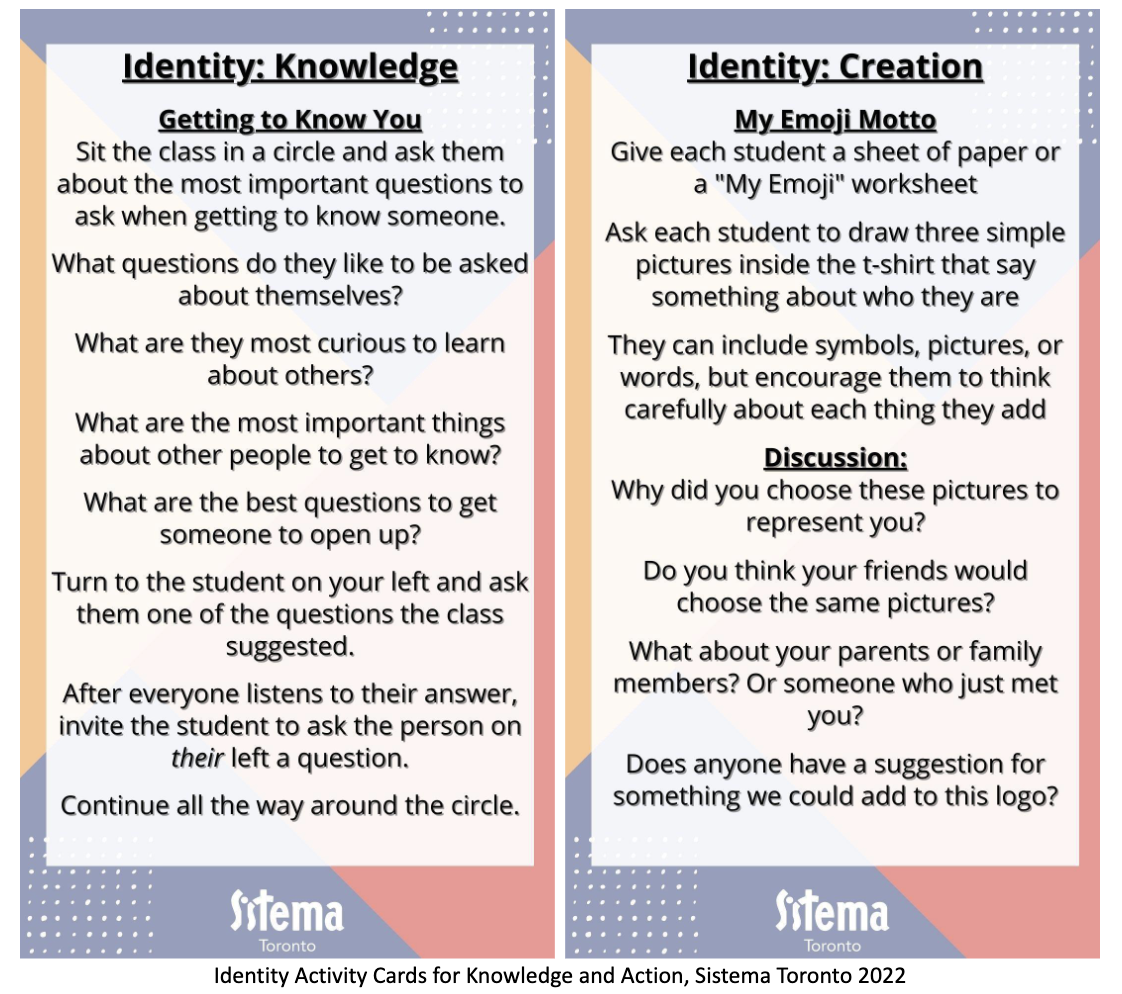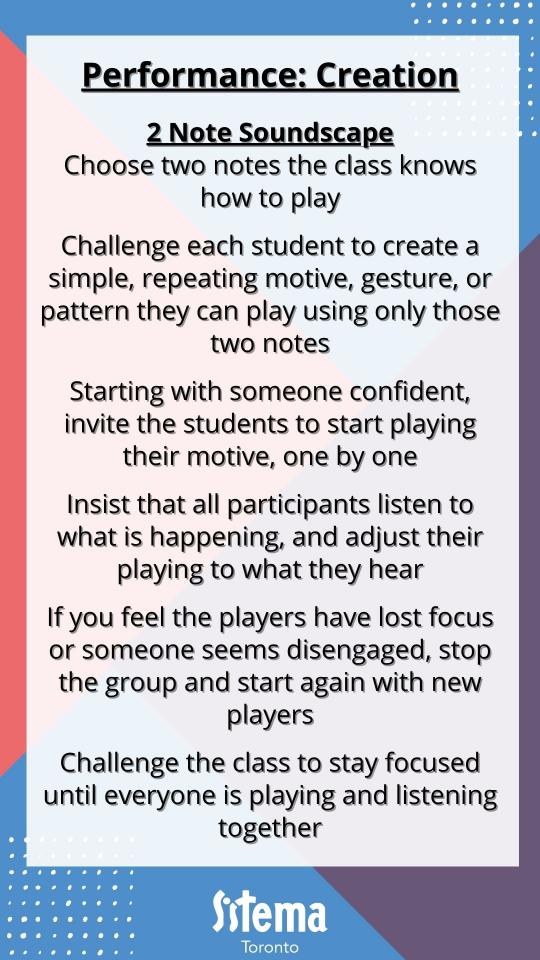Welcome to another year of Sistema Toronto’s Curriculum Blog. Each entry of the blog will cover different aspects of curriculum design, development, and implementation, through the lens of our curriculum calendar and the events happening in our program. This time we’ll be talking about the start of our year, and some of the resources we put together to help our teachers start the year off right.
This year the focus of our curriculum team will be implementation. After two years of constant change and disruption, first moving the program online and then adapting to each new round of lockdown and reopening, our program is returning to something like its normal rhythm. Adapting to online classes challenged us to innovate, developing new activity formats, adopting new technologies and tools, and rethinking how we taught our students over and over. Returning to in-person classes offers us the opportunity to dig in and think more deeply about what we are doing in our classes.
In the academic calendar, fall is always a time of renewal and fresh starts. New students join, and old students return with new stories to tell about themselves. This year we are also welcoming an extraordinary number of new teachers and Centre Directors to our program. The pandemic has been particularly hard on the performing arts, with halls and venues closed, audience sizes capped, travel disrupted, and tours cancelled. Reopening has led to further disruptions, with increasing rent and affordability challenges on the one hand, and a tight labour market with lots of opportunities on the other. Many artist have turned to careers outside the arts or have moved away from Toronto in an effort to find more affordable living. The return to in-person programming has allowed us to accept more new students, and expand our staff. As a result of these factors we have a tremendous number of new students and more than half of our teaching team are either new to Sistema Toronto, or are taking on a new position this fall.
To help welcome our new and returning students to the program, our curriculum focuses on topics and activities designed to get our students talking and playing. This September our Social Curriculum focus was Identity, and we also explored playing activities to help get our ensembles off to a fun and engaging start. To help welcome our new teachers and introduce them to our program culture and teaching methods, we developed three infographics that give an overview of our curriculum structure and materials.
Social Curriculum: Identity
Celebrating our students’ identities is a central element of our Social Curriculum. We want our students to feel seen and heard in our program, and to understand that they are welcomed for who they are. Activities like “Getting to Know You” and “Emoji Motto” challenge our students to create a welcoming classroom environment in which everyone feels comfortable expressing their identity in a group setting.

Performance Curriculum: Improvisation
Another important challenge every fall is how to get everyone engaged in their playing as quickly as possible. Each year our ensembles all welcome new students, who have to adapt to the routines and challenges of their more experienced classmates. “2 Note Soundscape” offers the chance for every student to participate immediately, using only two notes to create an interactive piece of music the whole class can participate in.

Performance Card for Creation, Sistema Toronto 2022
The instructions are written to encourage the students to focus, listen, and respond creatively to what they hear, and to challenge them to hone their ensemble skills. Limiting the scope to only two notes encourages participants to engage creatively with tone, dynamics, and rhythm, while also encouraging everyone to stay engaged with the full group sound.
Activities like this, which focus on student engagement and creativity rather than note learning and error correction, make it possible for students who might struggle to keep up with their peers in a written piece to succeed or even excel in an ensemble setting, and make them feel more welcome in their new classes.
Welcoming New Teachers: Curriculum Overview
With the return to in-school programming, our teaching team welcomed fifteen new teachers this fall. Including teachers who have moved centres or taken on new roles as Centre Directors, more than half our staff are in new roles this fall.
As part of our onboarding process, we designed three infographics about our curriculum, each of which would show a different element of our curriculum design.
Putting these materials together in a simple, appealing layout challenged us to organize our ideas thoughtfully, express them clearly, and to relentlessly edit so that everything reads well and looks good on a phone or a computer screen.
The first infographic was about the overall program structure, laying out the main structural elements of our curriculum, our three Curriculum Areas (Social Curriculum, Theory and Musicianship, and Instrumental and Vocal Technique) and the four types of activity we use to explore each of these in the classroom (Knowledge, Action, Perception, and Creation).
It also introduces the digital activity format we use for sharing these materials and provides some guiding questions for thinking about the curriculum as a whole.
Distilling this content down into a simple, visually appealing format challenged us to clarify our ideas, and prioritize the messages and contents that were most important to our program culture.
Organizational Culture: Social Curriculum
The second infographic focused on our Social Curriculum. Each month our Social Curriculum focuses on a different theme: Identity, Respect, Communication, Teamwork, Listening, Leadership, Problem Solving, Responsibility, Organization, or Community.
Each week our teachers receive example activities, showing how these different themes can be explored in the classroom through the lens of Knowledge, Action, Perception, and Creation.
Teachers are encouraged to adapt the activities, or create their own, and many of our best were adapted in turn from activities we observed in the classroom.
As important as it was to familiarize our teachers with the contents and structure of the Social Curriculum, we also wanted to make it clear that these activities are central to our program’s identity, and that we consider social learning equally important to musical learning.
Teacher Resources: Theory and Musicianship
Our final infographic focused on Theory and Musicianship. Last fall we launched a new Theory and Musicianship Curriculum, structured much like our Social Curriculum with twelve themes and four activity types.
Interested readers can read more about the challenges that led us to create this curriculum, the structure we adopted for it, the writing and communications strategies we implemented, and the digital activity card format we developed in our 2021-2022 Curriculum Blog Entries at sistema-toronto.ca/curriculum-blog.
Last year we covered the first six Theory and Musicianship Curriculum themes, Pitch, Rhythm, Dynamics, Style, Intervals, and Scales. This year will introduce the six remaining themes: Harmony, Beat, Conducting, Form, Melody, and Patterns.
As in our Social Curriculum, new activities in our Theory and Musicianship Curriculum are rolled out by theme in weekly emails, and older materials are saved and made available to teachers to use at any time. The activities are designed to be usable with groups of any age and level, and to be easily adaptable to different class contexts.
This system has other advantages too. It encourages teachers to cover a broad base of topics, and that it provides a constant influx of materials and ideas to aid in their lesson planning.
On the other hand, sending the activities out this way creates certain challenges. Since activities for each theme are only sent out during that month, teachers need to be aware of what else is available and how to access it.
For new teachers, this makes understanding the structure of this curriculum particularly important. Not only is it significantly different from other approaches to teaching theory they are likely to have encountered before, but it also relies on their initiative to seek out activities from other themes as needed.
Professional Development and Teacher Onboarding
These infographics proved to be an efficient way to introduce our new and returning staff to the curriculum structure and materials, and led to a lively and constructive discussion around implementation. Creating these materials pushed us to think through our ideas and communicate them effectively, and working up an appealing design helped us express our program culture and make everything more approachable. This in turn made it easier to spend time on deeper and more nuanced discussions as a team, and to give our teachers a sense of our organizational culture and teaching philosophy in only a few short hours.
Next Time
In our next blog entry, we’ll be looking at some of the activities from our October Theory and Social Curriculum themes, Harmony and Responsibility.